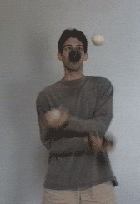The following article first appeared in the May/Jun 2001 issue of JUGGLE magazine. The publisher has kindly given permission to reproduce it here.
Some thoughts on how to learn a Four-Ball Mills Mess
An extremely complicated pattern for even accomplished jugglers is adding a fourth ball to Mills Mess. Many jugglers I know who have learned the pattern could not explain what they were doing. Since I am not a natural born juggler, I had to go through and figure out all the individual steps. Even that wasn't enough. I then had to come up with several approaches, and some preliminary exercises to work on so I could finally learn a Four-Ball Mills Mess.
The first concept to understand is that the Four-Ball Mills Mess follows the basic rule of most four-ball patterns, two balls are juggled independently in each hand. Balls don't cross over from hand to hand in a Four-Ball Mills Mess, just as they don't change hands when juggling a four-ball Fountain or four balls in Columns. The exclusive relationship of white balls only to the left hand and black balls only to the right hand is particularly difficult to see because both hands keep crossing over each other, while throwing and catching balls on the opposite side of the body. This blur of activity makes it look to many as if all four balls are circling around all four hands. OK, there are only two hands. In the beginning, it may seem as if one needs four hands to be able to juggle this pattern.
A quick review, there are three positions in which one throws a ball for Mills Mess. The first position is when the right arm is crossed over the left, the second position is the right arm crossed under the left, and the third position is when the arms are uncrossed. Of course, the first position could be expressed by saying the left arm is crossed under the right. Similarly, the second position can be seen as the left arm crossed over the right. Uncrossed arms remain uncrossed, no matter which arm is used as the first reference. Although this may be obvious on retrospection, it's worth pointing out that when juggling Mills Mess your arms are crossed twice as often as they are uncrossed. The great thing is, these are the only types of throws to make when juggling Mills Mess. It doesn't change when you add more objects. Mills Mess with three, four, five, or more balls still involves only six throws. So, if you can already juggle Mills Mess with three, you are well on the way to learning Four-Ball Mills Mess.
Preliminary Exercises
Since all throws in Mills Mess can be thought of as crossed-arm and uncrossed arm variations on the Reverse Cascade, it is important to be able to juggle two balls in each hand in a Reverse Fountain. Of the three basic two-ball patterns, Columns, Fountain, and Reverse Fountain, the Reverse Fountain is the most challenging for most people.
If you aren't already comfortable with the Staggered Reverse Fountain, please work on it until you can juggle this smoothly. Without a smooth, accurate Staggered Reverse Fountain, you will never master a Four-Ball Mills Mess. To review: a Staggered Reverse Fountain is when you alternately throw two balls from each hand, from the outside to the inside.
This web site has four approaches to learning a Four-Ball Mills Mess. If you are having trouble with one of the methods, try another. The order of the learning methods roughly goes from the fastest way to learn, to the most thorough.
First method: Understanding and Juggling the Pattern
The two things to know about Four-Ball Mills Mess are:
- The pattern is similar to the standard, four-ball Staggered Reverse Fountain. Two balls always stay with the left hand, two balls always remain with the right hand.
- You cross and uncross your hands, just as in a three-ball Mills Mess.
The pattern is similar to the standard, four-ball Staggered Reverse Fountain. Two balls always stay with the left hand, two balls always remain with the right hand. You cross and uncross your hands, just as in a three-ball Mills Mess.
I once explained Four-Ball Mills Mess this way to a student in France. I was doubtful that the explanation would be of use, as I didn't even speak the language properly. He seemed content, however. The next day he returned and demonstrated a decent Four-Ball Mills Mess. The tips were enough for him to learn the pattern, and may be enough for you, as well. If this is all you need to nudge you into juggling the pattern, you are one of the lucky few.
copyright 2001 by Todd Strong

- Home
- About
- Ball Juggling
- Cigar Boxes
- Club Juggling
- Club Swinging
- Comedy Writing
- Cup Stacking
- Devil Sticks
- Diabolo
- Diabolo Postcards
- Dice Stacking
- Hat Manipulation
- Lasso
- Miscellanous Juggling
- Parachute Games
- Poi Swinging
- Ring Juggling
- Shaker Cups
- Skill Games
- Staff
- Tennis Balls and Can
- New Games Foundation
- Ordering and Shipping
- Contact Information
- Peeps (photos of birds and stuff)
- Personal Thoughts
- Workshops
- Links
- Questions? Comments? Feedback?
